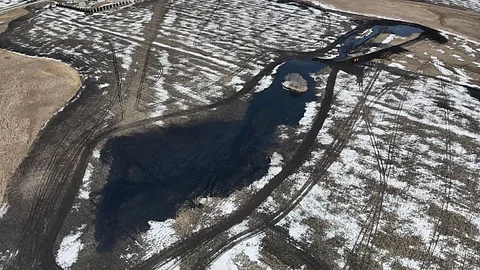

It couldn’t come at a worse time.
Now a major oil spill from the Keystone Pipeline is now confirmed to be significantly larger than initially reported, prompting a high-level federal investigation and renewed outrage from environmental groups.
Calgary-based South Bow Corp., the operator of the pipeline, estimates the line leaked about 3,500 barrels — equivalent to roughly 147,000 gallons of crude oil or half a million litres — making it the eighth-largest pipeline oil spill in either Canada or the US over the past decade.
By comparison, the original Keystone — not to be confused with the rejected Keystone XL pipeline — pumps about 600,000 barrels per day (bpd) of heavy oil from Alberta to Texas.
The rupture occurred last Tuesday near Fort Ransom, North Dakota, contaminating agricultural land and prompting an immediate shutdown of the 4,300-kilometre pipeline that transports crude oil from Alberta, Canada, to refineries along the US Gulf Coast.
Excavation and repair work at the site has been delayed due to the presence of thick oil sludge, state environmental officials said Friday. Cleanup crews have recovered more than 1,100 barrels of crude so far, and the affected section of pipe will soon be sent to a third-party lab for metallurgical testing.
In response to the spill, the US Pipeline and Hazardous Materials Safety Administration (PHMSA) has issued a formal Corrective Action Order (CAO), mandating a sweeping investigation into the root cause of the rupture.
American federal inspectors — six in North Dakota and two in Calgary — are overseeing the probe, which includes reviewing a decade of internal inspection reports and re-evaluating the pipeline’s special operating permit that allows for higher-than-normal pressure.
“PHMSA has already secured the operator’s full cooperation and written commitment to take any steps necessary to repair the line and identify the cause of the failure,” acting administrator Ben Kochman said in a statement.
South Bow says it hopes to resume operations by Tuesday, but the line cannot restart without PHMSA’s approval it said in its own assessment.
The incident comes at a particularly difficult time for Canada’s energy sector. President Donald Trump is currently weighing the possibility of tariffs on Canadian oil imports — a move that would further strain the cross-border energy and trade relationship in the midst of the Canadian federal election campaign.
The spill is likely to complicate those discussions, potentially giving ammunition to critics of expanded fossil fuel infrastructure.
Predictably, environmental groups expressed fury but not surprise.
“This is exactly the disaster we were warned about,” said Greenpeace USA senior researcher Tim Donaghy. “It’s the fourth major Keystone spill in under ten years. There is no safe way to transport fossil fuels — pipelines included.”
Meanwhile, South Bow maintains that safety and environmental protection are its top priorities. “We are committed to the community surrounding Fort Ransom and will continue cleanup activities until the site is fully remediated,” the company said in a statement.
